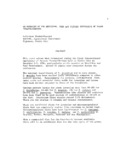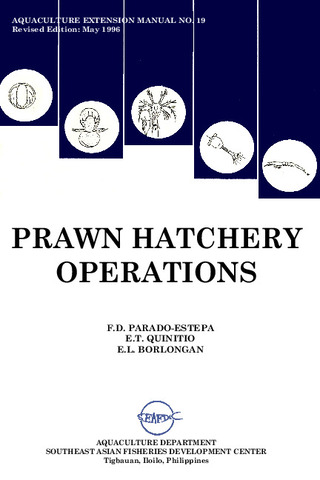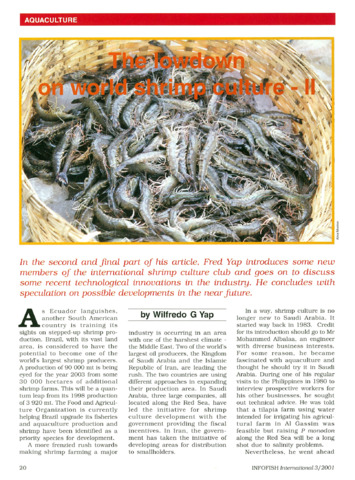Production of Penaeus monodon (Fabricius) using four natural food types in an extensive system
- Global styles
- MLA
- Vancouver
- Elsevier - Harvard
- APA
- Help

View/
Date
1993Page views
2,087ASFA keyword
AGROVOC keyword
Taxonomic term
Metadata
Show full item record
Share
Abstract
Growth, survival, and production of P. monodon feeding on four types of natural food, i.e., lablab (benthic mat of cyanobacteria, diatoms, and associated fauna), Ruppia maritima, lumut (filamentous green algae and attached organisms entangled in the water column and on the bottom), and plankton, were evaluated in ponds in Iloilo, Philippines. The gut content of shrimp was analyzed and the flow of the food web was traced using stable carbon isotope (δC) analysis. Twelve 500-m2 ponds were stocked with juvenile shrimp (average weight 0.8 g) and grown for 3 months at the rate of 4000 ha−1. In Ruppia and plankton ponds, the shrimp attained 91–92% survival, and in lumut and lablab ponds, 76–80%. Total shrimp production in Ruppia and plankton ponds was 114 and 129 kg ha−1 crop−1, while lumut and lablab ponds yielded only 59 and 85 kg ha−1 crop−1, respectively. The δC analysis of all treatments was not significantly different, indicating that a common food (detritus), as shown by the gut content analysis, appears to be the most significant food resource of shrimp in this study. Shrimp foreguts from all the treatments consisted of detritus (non-living particulate matter), copepod/animal remains, diatoms, cyanobacteria, and green algae. Detritus ranked highest in frequency of occurrence, followed by copepod/animal remains.
Suggested Citation
Bombeo-Tuburan, I., Guanzon, N. G., Jr., & Schroeder, G. L. (1993). Production of Penaeus monodon (Fabricius) using four natural food types in an extensive system. Aquaculture , 112(1), 57-65. https://doi.org/10.1016/0044-8486(93)90158-U
Type
ArticleISSN
0044-8486Collections
- Journal Articles [1256]
Related items
Showing items related by title, author, creator and subject.
-
An overview of the nutrition, feed and feeding techniques of prawn penaeid/shrimps
Piedad-Pascual, Felicitas (Philippine Council for Aquatic and Marine Research and Development, 1989)This paper echoes what transpired during the first International Conference of Penaeid Prawns/Shrimps held in Iloilo City in December 4-7, 1984, particularly on the Nutrition nd Feed Development. Around 25 papers were ... -
Series: Aquaculture extension manual; No. 19
Prawn hatchery operations
Parado-Estepa, Fe D.; Quinitio, Emilia T. ; Borlongan, Emeterio L. (Aquaculture Department, Southeast Asian Fisheries Development Center, 1996-05)
The manual, an updated version of the 1984 SEAFDEC/AQD manual, presents the underlying principles and step-by-step instructions of prawn larval and post-larval rearing. The techniques described are not only applicable to ...
; Borlongan, Emeterio L. (Aquaculture Department, Southeast Asian Fisheries Development Center, 1996-05)
The manual, an updated version of the 1984 SEAFDEC/AQD manual, presents the underlying principles and step-by-step instructions of prawn larval and post-larval rearing. The techniques described are not only applicable to ... -
The lowdown on world shrimp culture - II
Yap, Wilfredo G. (INFOFISH, 2001)This paper introduces some new members of the international shrimp culture club and goes on to discuss some recent technological innovations in the industry, particularly the polyculture of tilapia (mainly Oreochromis ...





